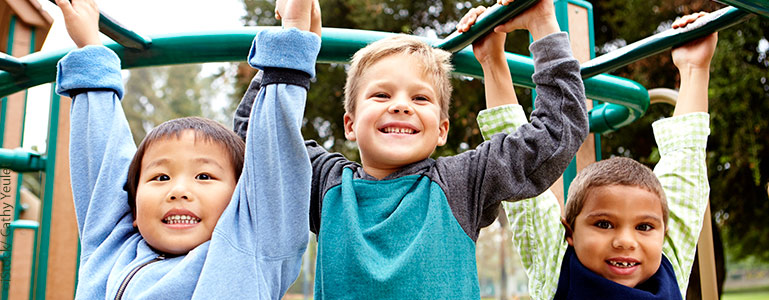When my daughter was four years old, we visited a friend with a large cat. The cat was heavy, but my daughter struggled mightily to pick her up. When she finally managed to gather the cat into her arms, nearly toppling over with the effort, the cat began purring. My daughter looked up at me with astonishment and said, “This one has a motor!”
I think about that phrase often when I’m working with parents and teachers of young children who have “motors” of their own. These kinesthetic, full-body kids have an intrinsic need to move in order to play, explore, and learn. They are the dancers, the leapers, the twirlers, the runners, the wigglers, and the sprinters that bring joy (and maybe some exhaustion) into our homes and classrooms.
How can we best nurture these creative and energetic kids, especially when we’ve designed our classrooms and inside spaces for more controlled exploration? How do we find a balance between high energy and quiet calming activities that meet the needs of all children? How do we provide meaningful experiences for children who learn through movement and are engaged by physical challenges?
We do this through careful reflection about our daily routines, child-friendly environments, and responsive practices at home and at school. For children with “motors,” parents intuitively (and sometimes through trial and error) plan a fun-filled day of play. Parks are great places to run, climb, tumble, swing, and bike. They are also useful places to rest and regroup under a tree, near the sandbox, or at a picnic table. Meeting up with other parents of active kids is always helpful, so the child has someone who can keep up with them for a sustained period of time. Like, all day.
The exuberance of a child in motion can be fun and exciting, wild and fear-inducing. There’s nothing quite as exhilarating as watching your “baby” reach the top of a very tall slide, leap off a swing at the peak of its arc, or run like a speed demon (usually in the opposite direction from where you’d like them to go). The challenge of raising an active child is not how to provide constant stimulation and discovery outside, but almost always about how to contain or manage the child’s energy when it’s time to go inside your home or classroom.
The good news is that there are plenty of ways to create physical, satisfying experiences and explorations inside as well as outside. Take a look around your environment. What big motor activities do you have at home or in school? A mini exercise trampoline in a corner goes a long way to meet the child’s need to bounce and move. A crawl-through tunnel, an obstacle course, a fort made out of couch cushions or large refrigerator boxes, a hippity-hop ball with a handle—these are all excellent choices for kinesthetic learners.
If you want an active child to listen, ask them to sit on a yoga ball or use a balance board or glider. Challenge them to 10 jumping jacks in a row before you call them to dinner or transition to the next activity. I guarantee that when you engage this child in a physically-stimulating way, you will get more compliance with parental or teacher requests. Try it out, and let us know what works for your full-body kid.
Heidi Emberling, MA, is an early childhood educator and child development specialist at Parents Place on the Peninsula.



